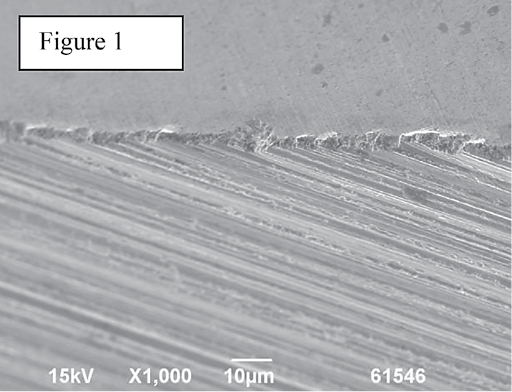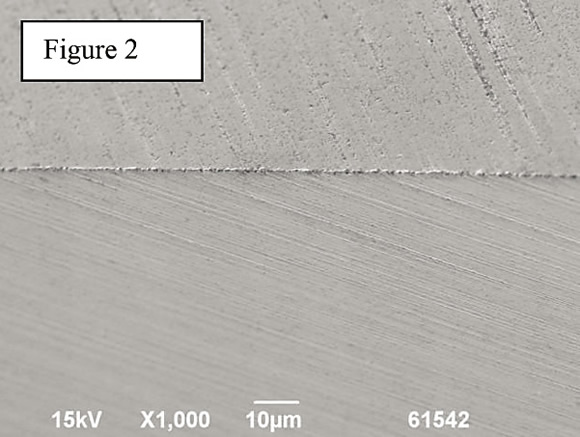END USER: Niagara Cutter LLC, (800) 861-6111, www.niagaracutter.com.
CHALLENGE: Improve cutting edge integrity and flute faces of cutting tools.
SOLUTION: A flute finishing process that uses a fine-grit, hybrid resin-bond flute polishing grinding wheel, special truing wheels and fine-grit dressing sticks.
SOLUTION PROVIDER: Norton/Saint-Gobain Abrasives, (254) 918-2313, www.nortonindustrial.com.
Manufacturers of round carbide cutting tools are continually seeking ways to improve their flute finishes. Finer surface finishes produce superior cutting edges, extend tool life, enhance workpiece finish, provide faster metal-removal rates and enable more efficient chip evacuation when machining ductile, nonferrous materials.

Niagara Cutter uses the Norton flute polishing process for imparting mirror finishes on its cutting tools, such as this endmill.
Niagara Cutter LLC, Reynoldsville, Pa., was one such toolmaker seeking to improve the cutting edges and flute gullets of its standard round carbide tools for machining aluminum alloys, as well as some of its specials, noted Jim Lundy, the company’s grinding technology manager.
He added that the flutes weren’t polished or loose abrasive media was applied. Polishing with loose abrasive, however, is a labor-intensive, manual process that requires skilled operators and often causes “edge dumping,” or rounding the cutting edge.
In addition to the media, the company applied a fine-grit grinding wheel, but was not achieving the desired results, Lundy noted.
A fine-grit wheel forms small chips during grinding, imparting fine grinding marks and minimizing surface and subsurface damage. The challenge, however, is to properly true and dress the wheel for the task.


The flute face and cutting edge of a cutting tool before (Figure 1) and after (Figure 2) applying a Norton fine-grit, hybrid resin-bond grinding wheel during the flute polishing process.
To achieve the desired results, Niagara Cutter contacted Norton/Saint-Gobain Abrasives, Worcester, Mass., to develop a wheel and process for polishing flutes. The grinding wheel manufacturer responded with a fine-grit, hybrid resin-bond wheel and specific truing and dressing requirements.
According to Kenneth Saucier, senior corporate applications engineer for Norton/Saint-Gobain, who developed the Norton flute polishing process, a flute surface has three major components: aesthetics, surface roughness (as measured in Ra) and surface integrity. “It is possible to get a very appealing finish but a poor cutting edge,” he said. “Using a fine-grit grinding wheel will allow you to achieve all three attributes.”
Niagara Cutter applies 1,000-grit wheels for flute polishing to enhance surface—and therefore cutting edge—integrity and aesthetics by imparting a mirror finish, although it does not target a specific Ra value. “A jagged cutting edge is typical without the Norton process on standard tools,” Lundy said.
The polishing wheel requires special truing wheels for rounding and profiling and 800-grit aluminum-oxide dressing sticks for exposing fresh diamond particles. Lundy emphasized the importance of maintaining open truing and grinding wheels when truing, a condition determined by operator touch during setup. “A standard operator is not going to experience success without some help,” he said. “The process has to be perfect.”
Although Lundy estimated that truing times increased about 20 percent with the Norton process, he doesn’t consider the additional 2 to 3 minutes significant.
In addition, the process, which Niagara Cutter performs both attended and unattended, adds a finish-pass step to the polishing cycle. For Niagara Cutter, the additional step increased cycle time for the polishing operation 5 to 10 percent, but that operation represents only about 10 percent of the overall cycle time, according to Lundy.
Lundy added that there was no spindle load for the polishing pass. Spindle load is equivalent to heat generation—carbide’s enemy—and, therefore, the additional polishing step does not compromise tool quality or integrity.
Having highly polished flutes, however, provides benefits to Niagara Cutter’s customers. “For drills, the polishing process adds lubricity,” Lundy said. “It’s a smooth surface and the chips are able to exit more freely.”
In addition, Lundy noted the flute polishing process not only extends tool life, but provides more consistent tool life.
Related Glossary Terms
- abrasive
abrasive
Substance used for grinding, honing, lapping, superfinishing and polishing. Examples include garnet, emery, corundum, silicon carbide, cubic boron nitride and diamond in various grit sizes.
- alloys
alloys
Substances having metallic properties and being composed of two or more chemical elements of which at least one is a metal.
- aluminum alloys
aluminum alloys
Aluminum containing specified quantities of alloying elements added to obtain the necessary mechanical and physical properties. Aluminum alloys are divided into two categories: wrought compositions and casting compositions. Some compositions may contain up to 10 alloying elements, but only one or two are the main alloying elements, such as copper, manganese, silicon, magnesium, zinc or tin.
- dressing
dressing
Removal of undesirable materials from “loaded” grinding wheels using a single- or multi-point diamond or other tool. The process also exposes unused, sharp abrasive points. See loading; truing.
- endmill
endmill
Milling cutter held by its shank that cuts on its periphery and, if so configured, on its free end. Takes a variety of shapes (single- and double-end, roughing, ballnose and cup-end) and sizes (stub, medium, long and extra-long). Also comes with differing numbers of flutes.
- flutes
flutes
Grooves and spaces in the body of a tool that permit chip removal from, and cutting-fluid application to, the point of cut.
- grinding
grinding
Machining operation in which material is removed from the workpiece by a powered abrasive wheel, stone, belt, paste, sheet, compound, slurry, etc. Takes various forms: surface grinding (creates flat and/or squared surfaces); cylindrical grinding (for external cylindrical and tapered shapes, fillets, undercuts, etc.); centerless grinding; chamfering; thread and form grinding; tool and cutter grinding; offhand grinding; lapping and polishing (grinding with extremely fine grits to create ultrasmooth surfaces); honing; and disc grinding.
- grinding wheel
grinding wheel
Wheel formed from abrasive material mixed in a suitable matrix. Takes a variety of shapes but falls into two basic categories: one that cuts on its periphery, as in reciprocating grinding, and one that cuts on its side or face, as in tool and cutter grinding.
- lubricity
lubricity
Measure of the relative efficiency with which a cutting fluid or lubricant reduces friction between surfaces.
- polishing
polishing
Abrasive process that improves surface finish and blends contours. Abrasive particles attached to a flexible backing abrade the workpiece.
- profiling
profiling
Machining vertical edges of workpieces having irregular contours; normally performed with an endmill in a vertical spindle on a milling machine or with a profiler, following a pattern. See mill, milling machine.
- truing
truing
Using a diamond or other dressing tool to ensure that a grinding wheel is round and concentric and will not vibrate at required speeds. Weights also are used to balance the wheel. Also performed to impart a contour to the wheel’s face. See dressing.


 ARTICLES
ARTICLES



